
Acipenseriformes is an order of basal ray-finned fishes that includes living and fossil sturgeons and paddlefishes (Acipenseroidei), as well as the extinct families Chondrosteidae and Peipiaosteidae. They are the second earliest diverging group of living ray-finned fish after the bichirs. Despite being early diverging, they are highly derived, having only weakly ossified skeletons that are mostly made of cartilage, and in modern representatives highly modified skulls.
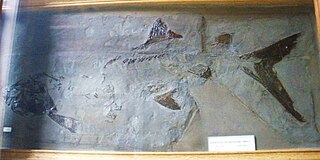
Chondrosteus is a genus of extinct actinopterygian belonging to the family Chondrosteidae. It lived during the Sinemurian in what is now England. Chondrosteus is related to sturgeons and paddlefishes as part of the clade Acipenseriformes. Similar to sturgeons, the jaws of Chondrosteus were free from the rest of the skull. Its scale cover was reduced to the upper lobe of the caudal fin like in paddlefish.

Lycoptera is an extinct genus of fish that lived from Lower Cretaceous, Barremian to Aptian in present-day China, North Korea, Mongolia and Siberia. Although there is record from Jurassic Formation in Siberia, its age remains questionable. It is known from abundant fossils representing sixteen species, which serve as important index fossil used to date geologic formations in China. Along with the genus Peipiaosteus, Lycoptera has been considered a defining member of the Jehol Biota, a prehistoric ecosystem famous for its feathered dinosaurs, which flourished for 20 million years during the Early Cretaceous, where it occurs abundantly in often monospecific beds, where they are thought to have died in seasonal mass death events. Lycoptera is a crown group teleost belonging to an early diverging lineage of the Osteoglossomorpha, which contains living mooneyes, arapaima, arowana, elephantfish and knifefish/featherbacks.
Paleontology or palaeontology is the study of prehistoric life forms on Earth through the examination of plant and animal fossils. This includes the study of body fossils, tracks (ichnites), burrows, cast-off parts, fossilised feces (coprolites), palynomorphs and chemical residues. Because humans have encountered fossils for millennia, paleontology has a long history both before and after becoming formalized as a science. This article records significant discoveries and events related to paleontology that occurred or were published in the year 1993.
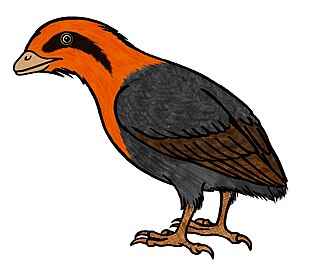
Liaoningornis is a genus of bird from Lower Cretaceous China. It was collected from the dinosaur-bearing beds of the Sihetun locality, of the Yixian Formation, Shangyuan, near the city of Beipiao in Liaoning province. The only known species is Liaoningornis longidigitris. It was described by Linhai Hou in 1996 and 1997.
Paleontology or palaeontology is the study of prehistoric life forms on Earth through the examination of plant and animal fossils. This includes the study of body fossils, tracks (ichnites), burrows, cast-off parts, fossilised feces (coprolites), palynomorphs and chemical residues. Because humans have encountered fossils for millennia, paleontology has a long history both before and after becoming formalized as a science. This article records significant discoveries and events related to paleontology that occurred or were published in the year 2000.
Paleontology or palaeontology is the study of prehistoric life forms on Earth through the examination of plant and animal fossils. This includes the study of body fossils, tracks (ichnites), burrows, cast-off parts, fossilised feces (coprolites), palynomorphs and chemical residues. Because humans have encountered fossils for millennia, paleontology has a long history both before and after becoming formalized as a science. This article records significant discoveries and events related to paleontology that occurred or were published in the year 2005.
Paleontology or palaeontology is the study of prehistoric life forms on Earth through the examination of plant and animal fossils. This includes the study of body fossils, tracks (ichnites), burrows, cast-off parts, fossilised feces (coprolites), palynomorphs and chemical residues. Because humans have encountered fossils for millennia, paleontology has a long history both before and after becoming formalized as a science. This article records significant discoveries and events related to paleontology that occurred or were published in the year 1982.

Paleontology or palaeontology is the study of prehistoric life forms on Earth through the examination of plant and animal fossils. This includes the study of body fossils, tracks (ichnites), burrows, cast-off parts, fossilised feces (coprolites), palynomorphs and chemical residues. Because humans have encountered fossils for millennia, paleontology has a long history both before and after becoming formalized as a science. This article records significant discoveries and events related to paleontology that occurred or were published in the year 2008.
Protoscaphirhynchus squamosus is an extinct sturgeon from the Late Cretaceous of North America. It is known from a single poorly preserved specimen found in the Maastrichtian aged Hell Creek Formation in Montana. Due to its poor preservational state, it has few diagnostic characters.
Paleopsephurus is an extinct genus of paddlefish (Polyodontidae). At present the genus contains the single species Paleopsephurus wilsoni. The genus is known from the Late Cretaceous (Maastrichtian) aged Hell Creek Formation of Montana.
Stichopterus is an extinct genus of chondrostean ray-finned fish that lived during the Early Cretaceous epoch in Asia. It has been found in Russia and Mongolia.

Strongylosteus is an extinct genus of prehistoric ray-finned fish that lived during the early Toarcian age of the Early Jurassic epoch. Its type species is Strongylosteus hindenburgi (monotypy). It is related to modern sturgeon and paddlefish (Acipenseroidei), but with a different kind of mouth than common species, made for hunting prey in open waters, with a strong lower jaw, similar to modern beluga sturgeon.
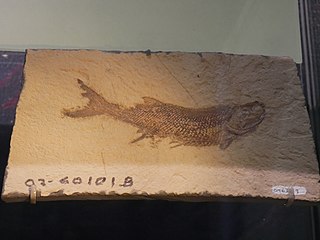
Cyranorhis is an extinct genus of prehistoric bony fish that lived during the Serpukhovian age of the Carboniferous period in what is now Montana, United States.
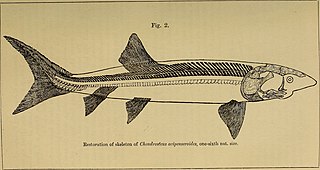
Chondrosteidae is a family of extinct marine actinopterygian fishes in the order Acipenseriformes. Three genera are known from the Early Jurassic of Europe, Chondrosteus, Gyrosteus, and Strongylosteus. Included species were of large size, with body lengths ranging from 2 metres (6.6 ft) up to 7 metres (23 ft). Their skeleton was largely made up of bones, but ossification was reduced compared to other ray-fins.

Bohaiornis is a genus of enantiornithean birds. Fossils have been found from the Lower Cretaceous Jiufotang Formation of western Liaoning, China. The only known species, Bohaiornis guoi, was named by Dongyu Hu, Li Li, Lianhaim Hou and Xing Xu in 2011 on the basis of a fully articulated and well-preserved skeleton of a sub-adult. This specimen, LPM B00167, preserved two long, ribbon-like feathers attached to the tail rather than a fan of shorter pennaceous feathers. It was similar to the slightly older Eoenantiornis, but much larger in size. Bohaiornis is the type species of Bohaiornithidae, a family of large predatory enantiornitheans from the Early Cretaceous.

Egg fossils are the fossilized remains of eggs laid by ancient animals. As evidence of the physiological processes of an animal, egg fossils are considered a type of trace fossil. Under rare circumstances a fossil egg may preserve the remains of the once-developing embryo inside, in which case it also contains body fossils. A wide variety of different animal groups laid eggs that are now preserved in the fossil record beginning in the Paleozoic. Examples include invertebrates like ammonoids as well as vertebrates like fishes, possible amphibians, and reptiles. The latter group includes the many dinosaur eggs that have been recovered from Mesozoic strata. Since the organism responsible for laying any given egg fossil is frequently unknown, scientists classify eggs using a parallel system of taxonomy separate from but modeled after the Linnaean system. This "parataxonomy" is called veterovata.
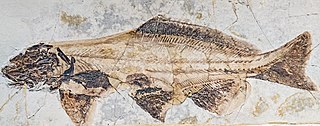
Peipiaosteidae is an extinct family of fish, known from the Late Jurassic and Early Cretaceous of Asia. They are members of Acipenseriformes, related to sturgeons (Acipenseridae) and paddlefish (Polyodontidae). Fossils have been found in freshwater deposits in China, Russia, Kazakhstan, and Mongolia. They are generally considered either the earliest diverging group of Acipenseriformes, or the sister group to the clade containing Acipenseridae and Polyodontidae. At least Yanosteus was likely to have been piscivorous, based on a specimen of Lycoptera found in the mouth of one specimen.
















